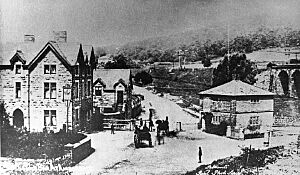Ambergate facts for kids
Quick facts for kids Ambergate |
|
|---|---|
 Ambergate from the west |
|
| Population | 5,013 (Heage and Ambergate Ward of Ripley, Derbyshire 2011) |
| District |
|
| Shire county | |
| Region | |
| Country | England |
| Sovereign state | United Kingdom |
| Post town | BELPER |
| Postcode district | DE56 |
| Dialling code | 01773 |
| Police | Derbyshire |
| Fire | Derbyshire |
| Ambulance | East Midlands |
| EU Parliament | East Midlands |
| UK Parliament | |
Ambergate (pronounced AM-ber-gate) is a village in Derbyshire, England. It's located where the River Amber meets the River Derwent. This village is about 6 miles (10 km) south of Matlock.
Ambergate is part of the Heage and Ambergate area. In 2011, about 5,013 people lived there. The village is special because it's inside the Derwent Valley Mills UNESCO World Heritage site. It has strong links to George Stephenson, a famous railway engineer. Ambergate is also known for its railway history and its telephone exchange. Every year, the village hosts a fun carnival.
The A610 road from Ripley and Nottingham meets the A6 road in Ambergate. The A6 runs north and south along the Derwent valley. Nearby places include Sawmills, Ridgeway, Alderwasley, Heage (where Heage Windmill is), Nether Heage, and Crich. The village is also surrounded by beautiful woods like Shining Cliff woods.
Contents
History of Ambergate
How Ambergate Got Its Name
Before the early 1800s, this area was called Toadmoor. It was just a few small houses for workers. Some people thought "Toadmoor" came from a local saying, "t'owd moor," meaning "the old moor."
However, experts who study place names found that "Toadmoor" likely meant "toadpool." This name was first used in 1397. The area is a valley bottom with floodplains and marshy spots near the River Derwent. So, "toadpool" makes more sense.
Even today, the southern part of the village is still shown as Toadmoor on maps. You can find the name in Toadmoor Lane and the Toadmoor Tunnel. The name "Amber Gate" first referred to a tollgate on the road to Nottingham. Later, the North Midland Railway used it for the Ambergate railway station.
Growth of Industry and Transport
In 1791, Benjamin Outram and Samuel Beresford built special ovens called kilns at nearby Bullbridge. They used these kilns to process limestone from their quarry in Crich. George Stephenson found coal nearby and realized he could use the leftover coal to burn the lime. He rented Cliff Quarry at Crich and built eight lime kilns next to the railway. Within a year, he had twenty kilns! These kilns were connected by a special wagonway called "The Steep." It was a 550-yard (500 m) long slope that wagons could go down on their own.
In 1818, a new toll road to Matlock was opened. Before this, the main road north from Belper went through Wirksworth. Most of the traffic was cotton from Arkwright's Mill at Cromford. The Cromford Canal, which opened in 1794, also runs past the village. You can walk along the canal towpath from Ambergate to Cromford Wharf. This path passes High Peak Junction, which is the start of the High Peak Trail. This 6-mile (10 km) section is a special area for nature and is part of the Derwent Valley Heritage Way.
In 1840, the North Midland Railway opened a station at 'Amber Gate'. This brought more visitors and trade to Matlock, which was becoming a popular spa town. By 1867, trains could travel directly from London St Pancras to Manchester and Leeds. Ambergate became an important place for changing trains. In 1876, Francis Hurt built the 'Hurt Arms' hotel. The main railway line goes through the oval-shaped Toadmoor Tunnel, which George Stephenson designed.
By 1851, the small village had grown to 206 people. In 1876, a company called Richard Johnson and Nephew opened a wire factory by the river.
Ambergate in the 1900s
By 1931, Ambergate's population reached 901. It grew to 1,794 people by 1951.
The quarry and the wagonway closed in 1957. The limeworks continued until 1965, when the Clean Air Act was passed. The kilns were taken down the next year to build a storage and processing plant for natural gas.
In 1966, the first fully working electronic telephone exchange in Europe opened in Ambergate. This was also the first small to medium electronic exchange in the world. It was the first of many TXE2 type exchanges.
Community Life
Ambergate has a lively community. Many activities happen around the school, local pubs, churches, and sports clubs. The village also has an annual carnival. This carnival is quite big and popular locally. It includes many fun events during carnival week and throughout the year. A group of volunteers organizes the carnival.
Images for kids
See also
 In Spanish: Ambergate para niños
In Spanish: Ambergate para niños




